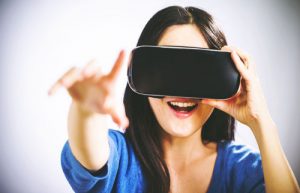Virtual Reality is here, and it’s here to stay. 2016 is the year when the likes of Oculus Rift, PlayStation VR and the HTC Vive take the medium mainstream.
In the 90’s, VR technology made a scratch onto the scene, however, it didn’t take off. In spite of the quick rise of VR popularity, the first coming out never made it. It was clunky, it was expensive, it wasn’t even suitable for the arcade, let alone something you could access in your own home. Its biggest crime of all, though, was probably that nobody behind it realized the need to manage our expectations. The world was disappointed with VR, interest waned, funding ceased and, along with it, the development of the technology. Fast forward to now, and VR is making a surge in the world of technology.
How do those goggles you wear really work? How is it that you can be standing in the dining room, ready to bust your knee on the chair, and all the while think you are standing on the red ground of Mars?
The question is, how do we get there? Total immersion is what everyone making a VR headset, app, or game is aiming towards by making the virtual reality so real that we forget the computer, the headgear and accessories, and we act exactly as we would in the real world.
The headset set-up is being used by Oculus, Sony, HTC, Samsung and Google and usually requires three things; a PC, console or smartphone to run the app or game, a headset which secures a display in front of your eyes (which could be the phone’s display) and some kind of input – head tracking, controllers, hand tracking, voice, on-device buttons or trackpads.
Since the goal of the hardware is to create what appears to be a life sized, 3D virtual environment without the boundaries set forth by ‘typical’ TV or computer screens, the screen mounted to your face follows you. This is unlike AR (augmented reality), which overlays graphics onto your view of the ‘real’ world.
VR headsets use either two feeds sent to one display or two LCD displays, one per eye. There are also lenses which are placed between your eyes and the pixels which is why the devices are often called goggles. In some instances, these can be adjusted to match the distance between your eyes which varies from person to person.
These lenses focus and reshape the picture for each eye and create a stereoscopic 3D image by angling the two 2D images to mimic how each of our two eyes views the world ever-so-slightly differently. Since each feed comes from a slightly different angle, the player’s brain is tricked into thinking that two 2D images are one 3D one. Try closing one eye then the other to see individual objects dance about from side to side and you get the idea behind this.
With the gaming community growing by staggering numbers, the equipment used in VR needs to be as precise as possible. At UKA we are proud to offer you a project that begins with in-house design and continues through in-house manufacturing.
Universe Kogaku designs and manufactures optical lenses for VR systems, security, high tech and electronic applications. We stock 1000’s of standard lens assemblies and can custom design a solution for scanners, CCTV, CCD/CMOS, medical imaging, surveillance systems, machine vision and night vision systems.